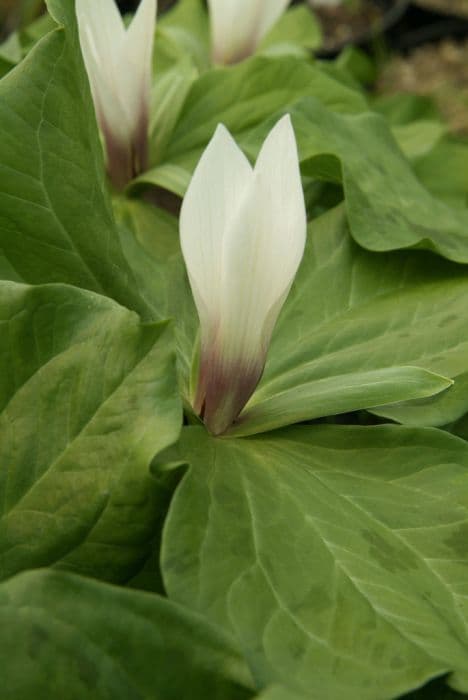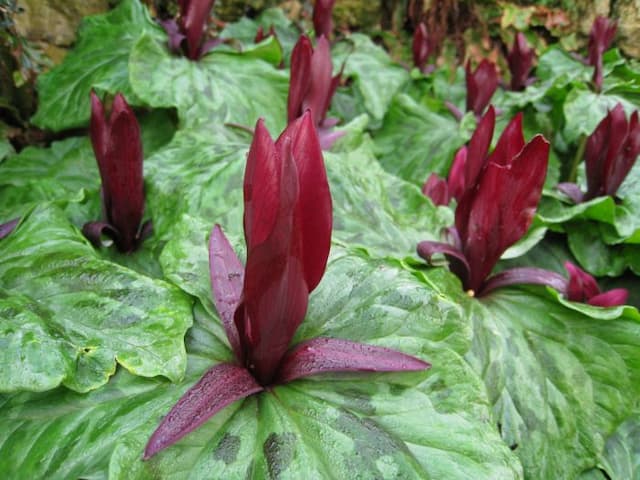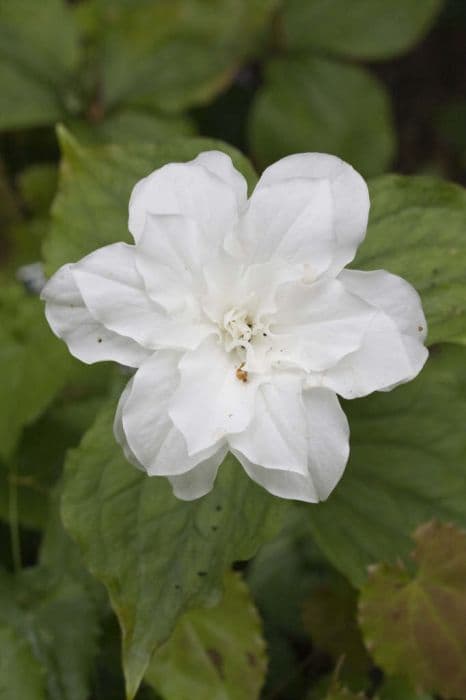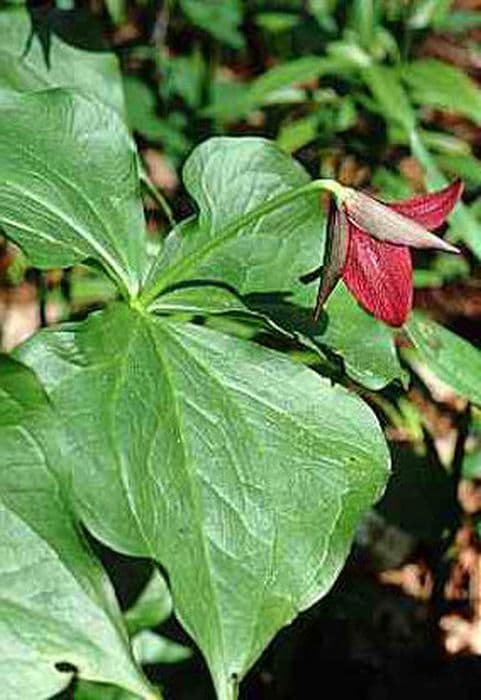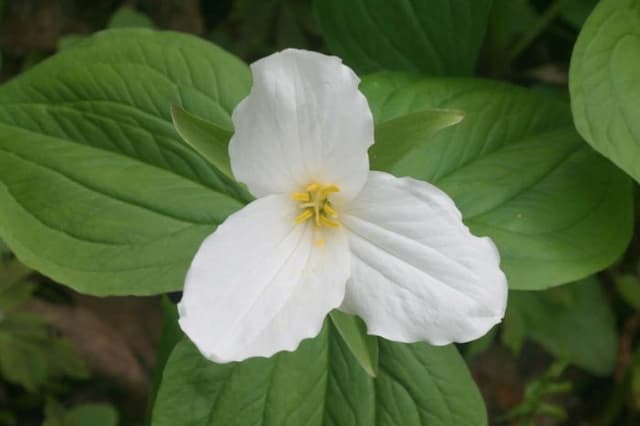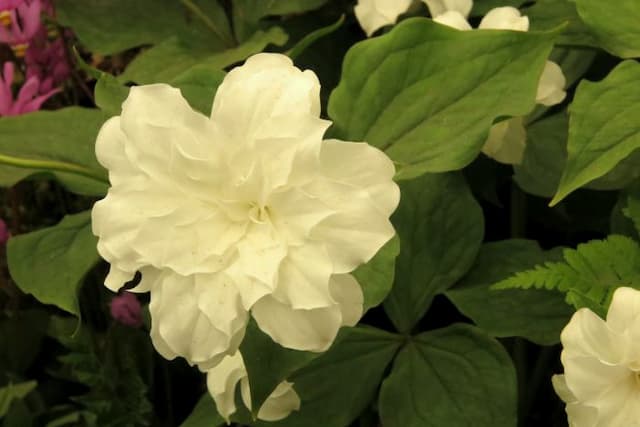Giant purple wakerobin Trillium kurabayashii

ABOUT
Trillium kurabayashii, commonly known as giant purple wakerobin, is a perennial plant that boasts a striking appearance. Each plant typically has a single, erect stem that emerges from the ground, topped by a whorl of three large, broadly ovate leaves. These leaves are usually deep green and can have a mottled appearance with varying shades of green. Above the leaves, the giant purple wakerobin showcases its singular, showy flower. The flower possesses three large petals which are a rich maroon or deep purple color, often with a velvety texture that invites closer inspection. The petals are complemented by three smaller, greenish or purple sepals that can sometimes be seen beneath the petals. At the center of the flower is a set of reproductive parts, including stamens and a pistil, which often protrude and are prominently visible, contributing to the unique structure of the bloom. This plant usually flowers in the spring, producing a captivating display that attracts pollinators to its petals. The overall impression of the giant purple wakerobin is one of robust beauty, with its combination of luxurious colors and a ground-level, yet prominently noticeable, floral display.
About this plant
 Names
NamesFamily
Melanthiaceae
Synonyms
Giant Purple Wakerobin, Kurabayashi's Trillium, Purple Trillium, Sesame Trillium
Common names
Trillium kurabayashii.
 Toxicity
ToxicityTo humans
Giant wakerobin does not have a well-documented profile of toxicity to humans. Generally, Trillium species are not considered highly poisonous, but they have not been extensively studied for their potential toxic effects if ingested. It is advisable to avoid consuming any part of this plant since the full extent of its toxicity is not well known, and it could potentially have adverse effects. If any part of the plant is ingested and symptoms occur, it is important to seek medical advice.
To pets
Giant wakerobin is not widely known to be toxic to pets, but as with humans, there is limited information on the specific effects of Trillium kurabayashii if ingested by animals. Since the complete toxicity profile of this plant is not well-documented, it is recommended to prevent pets from consuming any part of it to avoid any potential adverse reactions. If a pet does ingest giant wakerobin and displays any signs of illness, consult a veterinarian.
 Characteristics
CharacteristicsLife cycle
Perennials
Foliage type
Deciduous
Color of leaves
Green
Flower color
Maroon
Height
1-2 feet (30-60 cm)
Spread
1 foot (30 cm)
Plant type
Herb
Hardiness zones
7
Native area
Western North America
Benefits
 General Benefits
General Benefits- Ecosystem Support: Trillium kurabayashii, commonly known as giant purple wakerobin, is a native plant that provides food and habitat for local wildlife, including insects and mammals.
- Biodiversity Promotion: The presence of giant purple wakerobin helps maintain biodiversity by supporting a wide range of organisms within its native ecosystem.
- Landscape Aesthetics: With its striking purple flowers, this plant adds beauty and visual interest to gardens, parks, and wild landscapes.
- Erosion Control: The fibrous root system of giant purple wakerobin helps stabilize soil and prevent erosion in areas where it is native.
- Shade Garden Enhancement: Giant purple wakerobin is well-suited for shaded garden areas, providing a unique and attractive understory plant.
- Seasonal Interest: The plant has a distinct blooming period in spring, which adds seasonal interest to areas where it grows.
- Cultural Significance: As a native plant, giant purple wakerobin holds cultural significance for indigenous and local communities that value it for its presence in the natural landscape.
- Low Maintenance: Being native to its region, giant purple wakerobin typically requires less maintenance than non-native garden plants when grown in suitable conditions.
- Pollinator Attraction: The flowers of the giant purple wakerobin attract pollinators such as bees, which are vital for the pollination of many plants.
- Education and Research: As a native species, giant purple wakerobin provides opportunities for education and research on native flora and ecology.
 Medical Properties
Medical PropertiesThis plant is not used for medical purposes.
 Air-purifying Qualities
Air-purifying QualitiesThis plant is not specifically known for air purifying qualities.
 Other Uses
Other Uses- Shade Garden Specimen: Trillium kurabayashii, commonly known as giant purple wakerobin, can be used as a striking shade garden specimen due to its striking maroon flowers and broad foliage.
- Woodland Area Enhancement: The giant purple wakerobin can be planted in woodland areas to enhance the natural aesthetic and contribute to the diversity of native flora.
- Naturalizing in Forests: This species is suitable for naturalizing in appropriate forested areas, blending in with other native species to create a self-sustaining ecosystem.
- Erosion Control: The extensive root system of the giant purple wakerobin can help in controlling soil erosion on shaded slopes.
- Spring Interest: As an early bloomer, the plant can be used to add interest to gardens in spring before many other plants have started to leaf out or flower.
- Photography Subject: The distinctive appearance of giant purple wakerobin makes it a compelling subject for nature and garden photographers.
- Educational Tool: It can serve as an educational tool in botanical gardens or conservation areas to teach about native species and their habitats.
- Garden Borders: The low-growing nature of giant purple wakerobin allows it to be used as a natural border in shaded garden settings.
- Collector's Item: Because of its unique qualities, it can serve as a collector’s item for enthusiasts of native plants and rare species.
- Companion Planting: Giant purple wakerobin can be planted alongside other shade-tolerant species to create a diverse and aesthetically pleasing woodland understory.
Interesting Facts
 Feng Shui
Feng ShuiThe Giant Wakerobin is not used in Feng Shui practice.
 Zodiac Sign Compitability
Zodiac Sign CompitabilityThe Giant Wakerobin is not used in astrology practice.
 Plant Symbolism
Plant Symbolism- Purity: Trillium kurabayashii, commonly known as Giant Purple Wakerobin, often symbolizes purity due to its pristine white flowers that can sometimes have a slight purple tinge.
- Beauty: The striking appearance of its three-petaled flowers makes it a symbol of unique and natural beauty.
- Healing: In some cultures, trilliums are associated with medicinal properties and, therefore, can represent healing and recovery.
- Trinity: The three petals of the Giant Purple Wakerobin can symbolize different aspects of trinity found in various cultures and religions, such as the Christian Holy Trinity.
- Resilience and Rebirth: As a plant that emerges in the early spring, it is often associated with resilience and the rebirth that comes with the changing of seasons.
 Water
WaterThe Giant Wake Robin requires consistent moisture, especially during its active growth in spring. Water it deeply once a week, providing about 1 gallon of water per square foot of soil. During the dry summer months after its foliage dies back, reduce watering but do not let the soil become completely dry. In climates with wet winters, little to no additional watering is required. Always check the top inch of the soil for dryness before watering to avoid overwatering.
 Light
LightGiant Wake Robin thrives best in dappled shade, similar to its natural woodland habitat. The ideal spot for the plant is under a canopy of trees that allows filtered sunlight to reach the foliage. Avoid placing it in direct, harsh sunlight as this can scorch the leaves and compromise its health.
 Temperature
TemperatureThe Giant Wake Robin is hardy and can survive a range of temperatures, from as low as 20°F to as high as 80°F. Ideally, this plant prospers in temperatures between 50°F and 70°F during its growing season. It is well adapted to the cooler temperatures of the understory in forested areas.
 Pruning
PruningThe Giant Wake Robin typically does not require regular pruning. Pruning is usually done to remove dead or damaged foliage, which can be done as needed. The best time for pruning is after the plant has gone dormant, in late summer or early fall.
 Cleaning
CleaningNot needed
 Soil
SoilFor Giant Wake Robin, the best soil mix is rich, well-draining loam with high organic matter content. Maintain a soil pH of 5.5 to 7.0 for optimal growth conditions.
 Repotting
RepottingGiant Wake Robins should be repotted every two to three years to replenish nutrients and prevent soil compaction.
 Humidity & Misting
Humidity & MistingGiant Wake Robin thrives best in moderate to high humidity levels, ideally between 50% and 70%.
 Suitable locations
Suitable locationsIndoor
Provide dappled light, cool temps, moist soil, and high humidity.
Outdoor
Partial shade, moist, rich soil, and mulch to retain moisture.
Hardiness zone
5-9 USDA
 Life cycle
Life cycleThe plant Trillium kurabayashii, commonly known as giant purple wakerobin, begins its life cycle as a seed, which germinates in cool, moist soil conditions, often taking several years to develop a root system and a shoot. After germination, a single leaf emerges, and the plant enters a juvenile phase, during which it slowly matures over several years, developing more leaves in a whorl pattern. Once mature, the plant produces a distinctive three-petaled flower, which is often purple or maroon, blooming in the spring and attracting pollinators such as bees and beetles. Following pollination, the flower develops into a berry-like fruit, which contains seeds that are dispersed by wildlife, particularly foraging animals that eat the fruit. During each growing season, the plant's perennial rootstock sustains it, allowing the plant to die back to the ground in winter and regrow from the same roots in the following spring. Giant purple wakerobin can live for many years, going through this growth and reproduction cycle annually once it reaches maturity.
 Propogation
PropogationPropogation time
Spring to Summer
The Trillium kurabayashii, commonly known as the Giant purple wakerobin, is a perennial plant that can be propagated through seed or division, but the most popular method is seed propagation. The best time to collect seeds is when the fruit has ripened and is about to split open, usually in the late summer or early fall. Once collected, the seeds need to be sown immediately or kept moist and cold-stratified for 60 to 90 days before sowing to enhance germination. This process mimics the natural winter conditions the seeds would experience in the wild. Seeds are sown shallowly in a moist, well-draining soil mix and kept in a shaded area. Germination can be slow and erratic, sometimes taking a few years to develop into mature, flowering plants.
